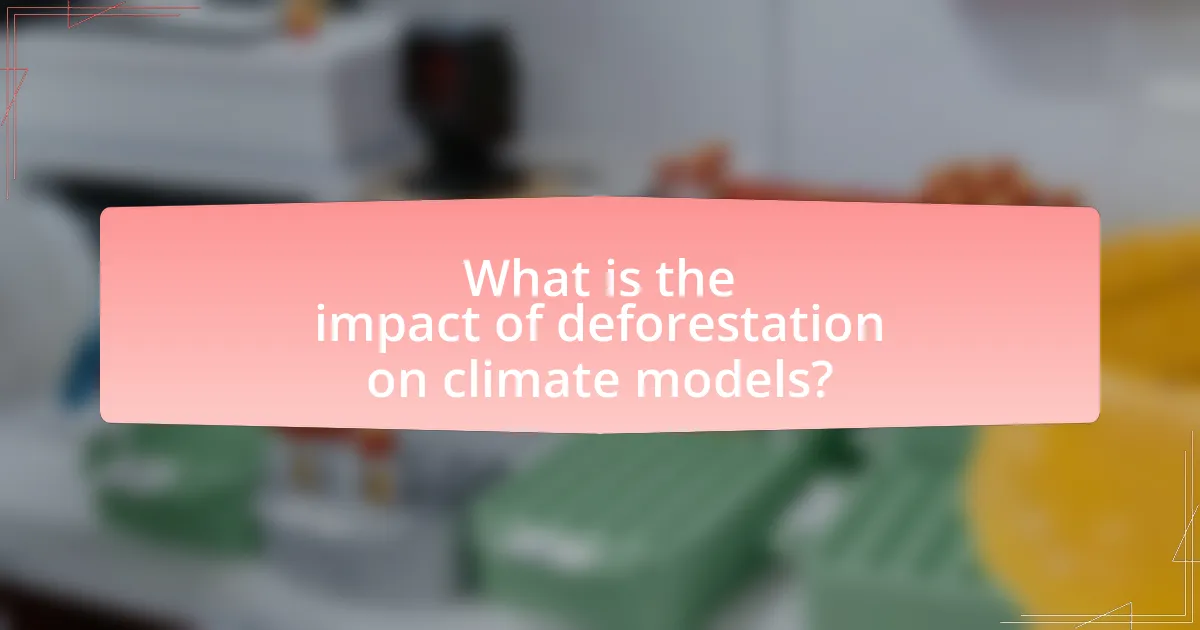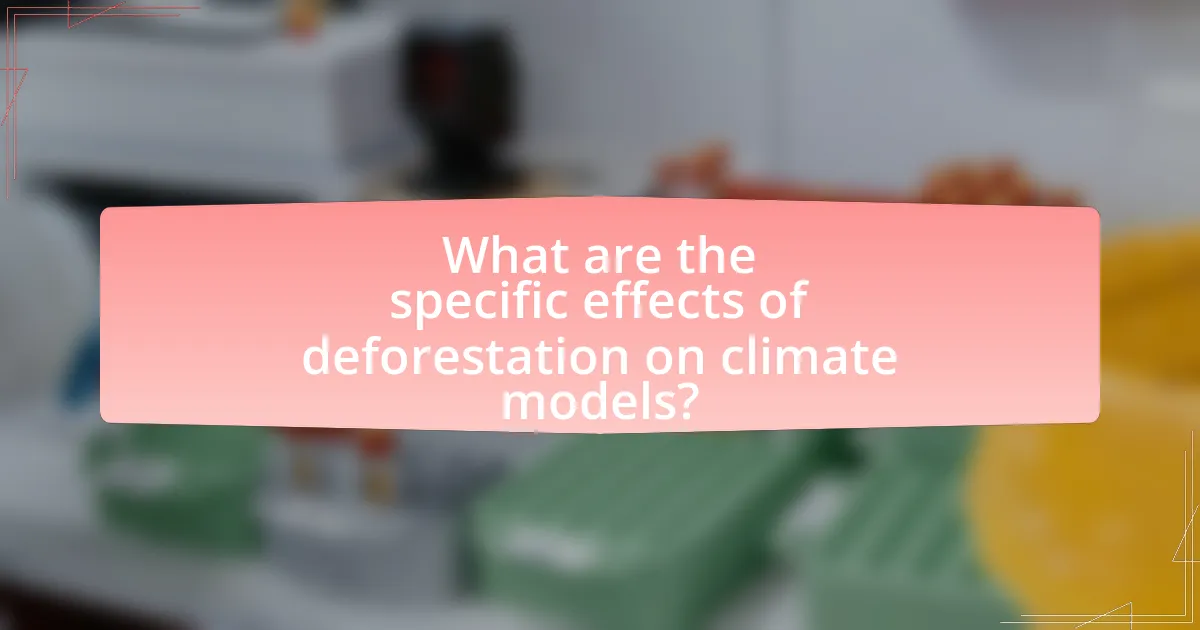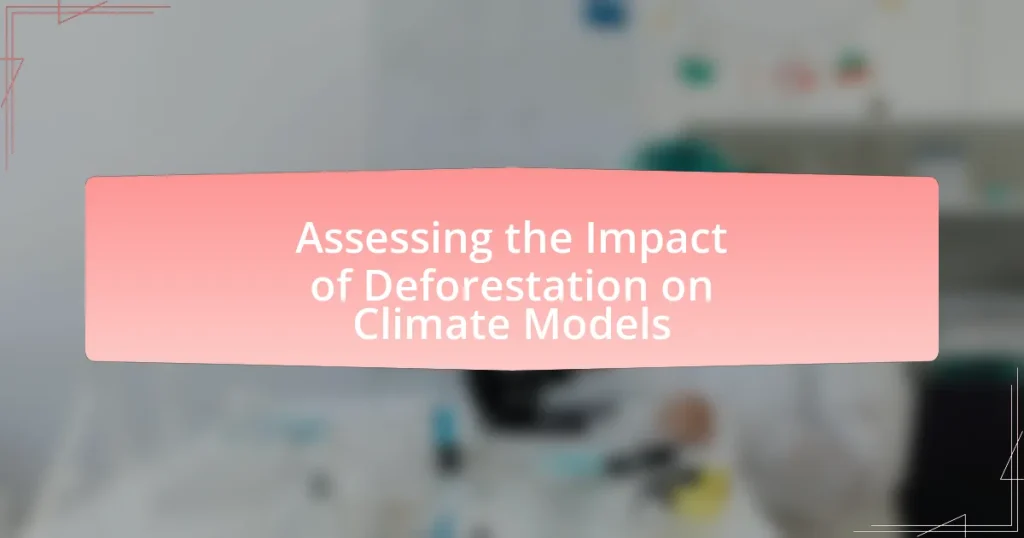The article focuses on assessing the impact of deforestation on climate models, highlighting how deforestation reduces the Earth’s capacity to sequester carbon dioxide, thereby increasing atmospheric CO2 levels and affecting climate predictions. It discusses the key factors influenced by deforestation, such as carbon storage, albedo changes, and hydrological cycles, which collectively undermine the accuracy of climate models. The article also examines methodologies for evaluating deforestation’s effects, including remote sensing and ecological modeling, and emphasizes the importance of accurate data in predicting climate change outcomes. Furthermore, it outlines potential strategies for mitigating deforestation’s impact, including reforestation and policy changes, to enhance climate model reliability.

What is the impact of deforestation on climate models?
Deforestation significantly alters climate models by reducing the Earth’s capacity to sequester carbon dioxide, which leads to increased atmospheric CO2 levels. This change affects temperature projections, precipitation patterns, and overall climate stability. For instance, a study published in “Nature Climate Change” by Houghton (2021) indicates that deforestation contributes to approximately 10-15% of global greenhouse gas emissions, thereby exacerbating climate change and skewing model predictions. Additionally, the loss of forests disrupts local and regional climates, influencing weather patterns and hydrological cycles, which are critical components in climate modeling.
How does deforestation influence climate change predictions?
Deforestation significantly alters climate change predictions by reducing the Earth’s capacity to absorb carbon dioxide, a key greenhouse gas. Trees play a crucial role in carbon sequestration; when forests are cleared, the stored carbon is released into the atmosphere, exacerbating global warming. According to a study published in “Nature Climate Change,” deforestation contributes to approximately 10-15% of global greenhouse gas emissions, which directly impacts climate models that rely on accurate carbon emission data to forecast future climate scenarios. This alteration in carbon dynamics leads to less reliable predictions regarding temperature increases, precipitation patterns, and extreme weather events, ultimately undermining the effectiveness of climate mitigation strategies.
What are the key factors in climate models affected by deforestation?
The key factors in climate models affected by deforestation include changes in carbon storage, alterations in albedo, and modifications to local and regional hydrology. Deforestation leads to a significant reduction in carbon sequestration, as trees that absorb carbon dioxide are removed, contributing to increased atmospheric CO2 levels. For instance, the Global Carbon Project reported that deforestation accounts for approximately 10% of global greenhouse gas emissions. Additionally, the removal of forests changes the land surface’s albedo, which can affect local temperatures and weather patterns. Lastly, deforestation disrupts the hydrological cycle by reducing transpiration, leading to changes in precipitation patterns and potentially exacerbating drought conditions. These factors collectively influence climate models’ accuracy and projections regarding future climate scenarios.
How do changes in land use alter climate model outputs?
Changes in land use significantly alter climate model outputs by modifying surface properties, which affects energy balance and greenhouse gas emissions. For instance, deforestation reduces albedo, leading to increased absorption of solar radiation, which can raise local temperatures. Additionally, land use changes can influence carbon storage; converting forests to agricultural land releases stored carbon dioxide, contributing to atmospheric greenhouse gas concentrations. Research indicates that land use changes account for approximately 10-15% of global greenhouse gas emissions, highlighting their critical role in climate modeling.
Why is it important to assess deforestation’s impact on climate models?
Assessing deforestation’s impact on climate models is crucial because it directly influences predictions of climate change and its effects on ecosystems and human societies. Deforestation alters carbon storage and greenhouse gas emissions, which are key variables in climate models. For instance, the Global Carbon Project reported that deforestation contributes approximately 10% of global carbon dioxide emissions, significantly affecting atmospheric concentrations and climate patterns. Understanding these dynamics allows for more accurate climate projections and informs policy decisions aimed at mitigating climate change.
What are the potential consequences of inaccurate climate predictions?
Inaccurate climate predictions can lead to severe consequences, including misguided policy decisions, economic losses, and increased vulnerability to climate-related disasters. For instance, if climate models underestimate the severity of temperature increases, governments may fail to implement necessary mitigation strategies, resulting in inadequate preparedness for extreme weather events. A study by the National Oceanic and Atmospheric Administration (NOAA) indicates that inaccurate climate forecasts can cost economies billions in disaster recovery and infrastructure damage. Additionally, mispredictions can disrupt agricultural planning, leading to food shortages and economic instability, as evidenced by the 2012 U.S. drought, which was exacerbated by flawed climate projections.
How does deforestation affect global temperature and precipitation patterns?
Deforestation increases global temperatures and alters precipitation patterns by reducing the Earth’s capacity to absorb carbon dioxide and disrupting local and regional climates. Trees play a crucial role in carbon sequestration; their removal leads to higher atmospheric CO2 levels, which contribute to the greenhouse effect and global warming. According to a study published in the journal “Nature,” deforestation in the Amazon rainforest has been linked to a rise in local temperatures by approximately 1.5 degrees Celsius and has caused significant changes in rainfall distribution, leading to drier conditions in some areas and increased flooding in others. This alteration in precipitation patterns can further exacerbate droughts and affect agricultural productivity, demonstrating the interconnectedness of deforestation and climate dynamics.
What methodologies are used to assess deforestation’s impact on climate models?
Methodologies used to assess deforestation’s impact on climate models include remote sensing, ecological modeling, and statistical analysis. Remote sensing utilizes satellite imagery to monitor forest cover changes and quantify deforestation rates, providing data on land-use changes over time. Ecological modeling simulates the interactions between deforestation and climate variables, allowing researchers to predict potential climate outcomes based on different deforestation scenarios. Statistical analysis involves examining historical climate data alongside deforestation metrics to identify correlations and causal relationships. These methodologies collectively enhance the understanding of how deforestation influences climate systems, as evidenced by studies that demonstrate significant alterations in local and global climate patterns due to forest loss.
How are data collected for analyzing deforestation effects?
Data for analyzing deforestation effects are collected through remote sensing, field surveys, and satellite imagery. Remote sensing utilizes satellite technology to monitor forest cover changes over time, providing comprehensive data on deforestation rates. Field surveys involve on-the-ground assessments to gather information on biodiversity, soil quality, and ecosystem health, which are directly impacted by deforestation. Satellite imagery, such as that from NASA’s Landsat program, offers high-resolution images that allow researchers to quantify forest loss and assess the spatial distribution of deforestation. These methods collectively enable scientists to analyze the ecological and climatic impacts of deforestation accurately.
What remote sensing technologies are utilized in this assessment?
The remote sensing technologies utilized in this assessment include satellite imagery, LiDAR (Light Detection and Ranging), and aerial photography. Satellite imagery provides comprehensive data on land cover changes over time, allowing for the monitoring of deforestation patterns. LiDAR technology offers high-resolution 3D mapping of forest structures, enabling precise measurements of tree height and biomass. Aerial photography complements these technologies by capturing detailed images of specific areas, facilitating ground-truthing and validation of satellite and LiDAR data. These technologies collectively enhance the accuracy of assessing deforestation’s impact on climate models.
How do ground-based observations complement remote sensing data?
Ground-based observations complement remote sensing data by providing high-resolution, localized information that enhances the accuracy of remote sensing interpretations. Remote sensing offers broad spatial coverage and temporal data, but it often lacks the fine-scale detail necessary for understanding specific ecological processes. For instance, ground-based measurements of soil moisture, temperature, and vegetation health can validate and calibrate satellite data, ensuring that remote sensing analyses reflect true environmental conditions. Studies have shown that integrating ground-based data with remote sensing improves model predictions of deforestation impacts on climate, as evidenced by research published in “Remote Sensing of Environment” by Turner et al. (2015), which highlights the importance of ground truthing in enhancing the reliability of remote sensing applications in ecological monitoring.
What modeling approaches are employed to evaluate deforestation impacts?
Modeling approaches employed to evaluate deforestation impacts include remote sensing, ecological modeling, and integrated assessment models. Remote sensing utilizes satellite imagery to monitor land cover changes and quantify deforestation rates, providing real-time data on forest loss. Ecological modeling simulates the interactions between forest ecosystems and climate variables, allowing researchers to predict the ecological consequences of deforestation, such as biodiversity loss and carbon emissions. Integrated assessment models combine socio-economic factors with environmental data to assess the broader impacts of deforestation on climate change, enabling policymakers to evaluate potential mitigation strategies. These approaches are validated through empirical studies that demonstrate their effectiveness in capturing the complex dynamics of deforestation and its consequences.
What are the differences between empirical and simulation models?
Empirical models are based on observed data and statistical relationships, while simulation models use mathematical representations to mimic real-world processes. Empirical models rely on historical data to identify patterns and make predictions, often using regression analysis, whereas simulation models create scenarios to explore potential outcomes by manipulating variables and parameters. For instance, in climate modeling, empirical models might analyze temperature changes based on historical deforestation data, while simulation models could project future climate scenarios under various deforestation rates. This distinction highlights that empirical models focus on what has happened, while simulation models explore what could happen under different conditions.
How do integrated assessment models incorporate deforestation data?
Integrated assessment models (IAMs) incorporate deforestation data by integrating land-use change dynamics into their simulations of climate and economic systems. These models utilize empirical data on deforestation rates, carbon emissions from land-use changes, and the ecological impacts of forest loss to project future scenarios. For instance, IAMs often employ data from sources like the Global Forest Watch, which provides real-time information on forest cover changes, enabling accurate assessments of how deforestation influences greenhouse gas emissions and climate change. By linking deforestation data with economic activities and climate policies, IAMs can evaluate the effectiveness of various mitigation strategies, demonstrating that deforestation significantly affects carbon cycles and climate outcomes.

What are the specific effects of deforestation on climate models?
Deforestation significantly alters climate models by increasing atmospheric carbon dioxide levels and disrupting local and global weather patterns. The removal of trees reduces the planet’s capacity to absorb CO2, leading to higher concentrations of greenhouse gases, which are critical inputs in climate models. For instance, studies indicate that deforestation contributes to approximately 10-15% of global greenhouse gas emissions, directly affecting temperature projections and precipitation patterns in climate simulations. Furthermore, deforestation can lead to changes in albedo, or surface reflectivity, which influences heat absorption and local climate conditions. This alteration can result in more extreme weather events, such as droughts and floods, which climate models must account for to improve accuracy in predicting future climate scenarios.
How does deforestation affect carbon cycling in climate models?
Deforestation significantly disrupts carbon cycling in climate models by reducing the amount of carbon stored in trees and altering the balance of carbon dioxide in the atmosphere. When forests are cleared, the carbon that was previously sequestered in biomass is released into the atmosphere, contributing to increased greenhouse gas concentrations. Research indicates that deforestation accounts for approximately 10-15% of global carbon emissions, as highlighted by the Intergovernmental Panel on Climate Change (IPCC) in their reports. This alteration in carbon dynamics affects climate models’ accuracy, as they rely on precise data regarding carbon fluxes to predict future climate scenarios. Consequently, the loss of forested areas leads to underestimations of carbon emissions and miscalculations in climate change projections.
What role does vegetation play in carbon sequestration?
Vegetation plays a crucial role in carbon sequestration by absorbing carbon dioxide from the atmosphere during photosynthesis and storing it in biomass and soil. Trees, plants, and other forms of vegetation capture approximately 30% of the carbon dioxide emissions produced by human activities annually, effectively mitigating climate change. For instance, a mature forest can sequester around 2.6 billion metric tons of carbon dioxide each year, highlighting the significant impact of vegetation on reducing atmospheric carbon levels.
How do changes in biomass influence atmospheric CO2 levels?
Changes in biomass directly influence atmospheric CO2 levels by altering the balance of carbon sequestration and release. When biomass, such as forests and vegetation, decreases due to deforestation, the capacity for carbon storage diminishes, leading to increased CO2 concentrations in the atmosphere. For instance, a study published in “Nature” by Pan et al. (2011) indicated that global forest biomass loss contributes significantly to annual CO2 emissions, estimated at approximately 1.1 billion tons of carbon per year. Conversely, when biomass increases through reforestation or afforestation, carbon is sequestered, which can help lower atmospheric CO2 levels. Thus, the dynamics of biomass changes are critical in understanding and modeling climate impacts related to CO2 fluctuations.
What are the implications of deforestation on hydrological cycles in climate models?
Deforestation significantly disrupts hydrological cycles in climate models by altering precipitation patterns and increasing runoff. The removal of trees reduces transpiration, which is a critical process for returning moisture to the atmosphere, leading to decreased rainfall in affected areas. Studies indicate that deforestation can lead to a 20-50% reduction in local precipitation, as evidenced by research conducted in the Amazon rainforest, where extensive logging has resulted in diminished rainfall and increased drought frequency. Additionally, deforestation increases surface runoff, which can lead to soil erosion and decreased water quality in rivers and streams. These changes in hydrological dynamics are crucial for climate models, as they can affect temperature regulation, carbon storage, and overall ecosystem health.
How does deforestation alter rainfall patterns and water availability?
Deforestation significantly alters rainfall patterns and reduces water availability by disrupting the local and regional hydrological cycles. Trees play a crucial role in the process of transpiration, where they release water vapor into the atmosphere, contributing to cloud formation and precipitation. When forests are removed, this process is diminished, leading to decreased rainfall in the affected areas. Studies indicate that regions experiencing deforestation can see a reduction in rainfall by up to 30%, as evidenced by research conducted in the Amazon rainforest, where deforestation has led to a marked decline in precipitation levels. Additionally, the loss of vegetation reduces soil moisture retention, further exacerbating water scarcity and impacting local ecosystems and agriculture.
What feedback mechanisms are triggered by changes in land cover?
Changes in land cover trigger several feedback mechanisms, including alterations in albedo, changes in carbon storage, and modifications in hydrological cycles. For instance, deforestation typically reduces forest cover, leading to a lower albedo effect, which increases heat absorption and contributes to local warming. Additionally, the removal of trees decreases carbon sequestration, releasing stored carbon dioxide into the atmosphere, thereby exacerbating greenhouse gas concentrations. Furthermore, changes in land cover can disrupt local precipitation patterns and increase surface runoff, affecting water availability and soil moisture levels. These mechanisms collectively influence climate models by altering temperature, precipitation, and carbon dynamics, which are critical for accurate climate predictions.
What strategies can be implemented to mitigate deforestation’s impact on climate models?
To mitigate deforestation’s impact on climate models, implementing reforestation and afforestation strategies is essential. These strategies involve planting trees in deforested areas and creating new forests in non-forested regions, which can significantly enhance carbon sequestration. For instance, a study published in “Nature” by Bastin et al. (2019) estimates that restoring 1 billion hectares of forest could capture up to 205 gigatons of carbon dioxide, thereby improving climate model accuracy. Additionally, enforcing stricter regulations on logging and promoting sustainable land-use practices can further reduce deforestation rates, ensuring that climate models reflect more accurate data on carbon emissions and ecosystem health.
What role do reforestation and afforestation play in climate modeling?
Reforestation and afforestation significantly enhance climate modeling by increasing carbon sequestration, which helps mitigate climate change. These practices contribute to the reduction of atmospheric CO2 levels, as trees absorb carbon during photosynthesis. According to the Intergovernmental Panel on Climate Change (IPCC), reforestation and afforestation can sequester up to 1.1 gigatons of CO2 per year globally, thereby influencing climate models that predict future climate scenarios. Additionally, these activities improve local climate conditions, such as temperature and precipitation patterns, which are critical variables in climate models. By incorporating data from reforestation and afforestation efforts, climate models can more accurately project the impacts of land-use changes on global warming and climate variability.
How can policy changes influence deforestation rates and climate outcomes?
Policy changes can significantly influence deforestation rates and climate outcomes by implementing regulations that protect forests and promote sustainable land use. For instance, policies that enforce stricter logging regulations can reduce illegal deforestation, as evidenced by Brazil’s Forest Code, which led to a 70% reduction in deforestation rates in the Amazon from 2004 to 2012. Additionally, incentives for reforestation and sustainable agriculture can enhance carbon sequestration, contributing to improved climate outcomes. Research indicates that effective policy frameworks can lead to a measurable decrease in greenhouse gas emissions, thereby mitigating climate change impacts.
What best practices should be followed in assessing deforestation’s impact on climate models?
To assess deforestation’s impact on climate models effectively, researchers should employ a multi-faceted approach that includes integrating remote sensing data, utilizing robust statistical methods, and incorporating ecological dynamics. Remote sensing data provides accurate and timely information on forest cover changes, which is crucial for understanding the extent of deforestation. Statistical methods, such as regression analysis, help quantify the relationship between deforestation rates and climate variables, ensuring that models are grounded in empirical evidence. Additionally, incorporating ecological dynamics, such as species interactions and carbon cycling, allows for a more comprehensive understanding of how deforestation alters climate systems. These practices are supported by studies like those from the Intergovernmental Panel on Climate Change, which emphasize the importance of accurate data and modeling techniques in climate assessments.


